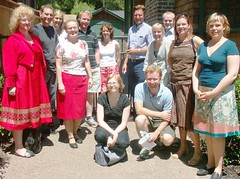University of the Future – is the Swedish Model optimal?
The Swedish delegation from VINNOVA, Chalmers, Gothenburg University, KTH and The Royal Swedish Academy of Engineering Sciences posing outside The HP Garage, the birthplace of Silicon Valley.
At Stanford again, just five days after the last workshop and barely un-jetlagged. This time it’s a workshop on the future of Swedish universities and university colleges with a focus on the ‘third role’ (samverkansuppgiften).
Universities have emerged as central actors in today’s knowledge-based economy. Their traditional role to provide society with research and well educated and talented people, have been extended to also influence social, cultural and economic development in society.
More and more emphasis is put on the way that new knowledge from research efforts is cared for and further developed. Universities are increasingly viewed as key drivers of innovation and ‘major agents of economic growth’. Research provides the key foundations for innovation which directly contributes to improved economic growth, productivity and quality of life, especially job creation and public awareness.
Can a combined “push” and “pull” in knowledge creation generate mutual satisfaction for the researcher and the stakeholders in the surrounding society? This question is highly relevant since public-funded research is intended to benefit the society as a whole, not just a single institution or a single researcher.
At the same time, researchers should, through competitive funding, be able to freely select the research field of their choice. Development of dynamic and open research environments with infrastructure and support system for profiled unique strength could attract and host researchers with diversity in depth and breadth of scientific interest. Research for research owns sake can thereby connect to more systematic and need-inspired research with a mutual benefit.
It can also be expected that the general public, politicians and media will increasingly question and scrutinize how knowledge is mediated and money is used in public-funded research.
- There are dramatic changes in how business performs research – tighter collaborations and even outsourcing to universities and research agencies is increasingly the case for major companies.
- Society generally is giving universities a central role – and universities are struggling to keep pace with demands made upon then.
- Governments everywhere are trying to create more innovative and competitive economies.
In an international comparison, there are some unique elements in the structure of Swedish research. The most significant and essential is the so-called “Swedish Model.” Universities and University Colleges are the country’s main research resource. The postgraduate student system is well developed and to a large extent involved in bringing the latest knowledge into society as they complete their studies in higher education.
The Swedish research institute sector is, at the same time, much smaller than in many other countries. As a result, universities are expected to engage in outreach activities and cooperation with the surrounding world. This is referred to as the “third mission, third stream or third task” which means that universities have the principal responsibility for applied research, implementation of research results and assigned education.














0 Comments:
Post a Comment
<< Home